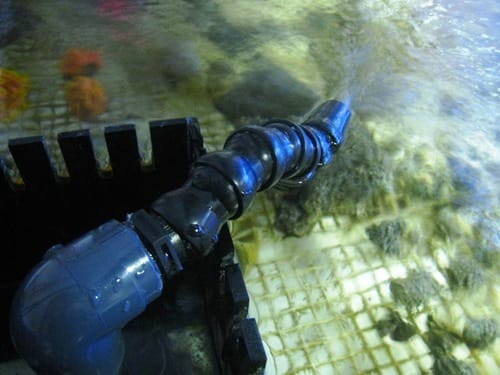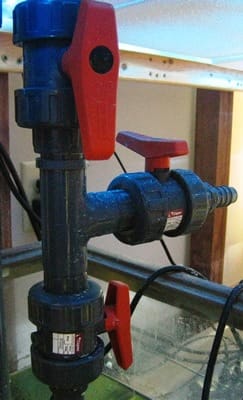The drain line is used to bring water from your display aquarium down to the sump. Your drain should be as large as possible, but most reef ready systems use a standard one inch Bulkhead. The pipe size can handle roughly 600 gallons per hour of flow. Many hobbyists struggle with bubbling and gurgling noises made by their drain. Most pre-built aquarium overflow kits come with some form of the Durso Standpipe, but you can also build one yourself with parts from the hardware store and some Loc-line. This type of drain works by allowing a tiny bit of air into the pipe to reduce slurping. You should also add a union valve below the bulkhead, but above the sump to make adjustments and disassembly easy in case you decide to move or need to make changes to the plumbing. The drain exit height into the sump may require some guesswork. Placed too far above the water’s surface will cause loud splashing and placed too far below the water’s surface will cause gurgling.

Plumbing the Return
Your return line is used to send water from your sump back up to the display tank. The standard reef ready aquariums uses a 3/4” bulkhead and most Return Pumps rated for 600 gallons per hour also have a 1/2″ or 3/4” outlet. In case of a power outage, you may drill a hole above the pump, but just below the water line to reduce back siphoning. You should also have the return nozzle breaking the water’s surface to further prevent back siphoning and flooding your floor. It is also useful to install a true union ball valve on the return pump, this will allow for minor adjustments and easy removal of the pump for service.

Another easy water change modification can be added to the return line. Tee off the return line and place a ball valve on the top and side of the tee. Through a series of fittings, attach a plastic hose that can be run to a drain. During normal operation the top tee ball valve will be open and the side ball valve closed. When you are ready to perform a water change, open the side ball valve and close the top ball valve. This will cause water to rush out.
Aquarium Plumbing Tips
Always remember to use hard plumbing or PVC whenever possible. When gluing two pieces of PVC together use primer and PVC glue to prevent leaks. Whenever flexible hosing is used, purchase plastic hose clamps to secure it to barbed fittings. Metal hose clamps will rust and break, which can result in a flood.
In summary, most Pre-Built Aquarium Overflow Kits come with bulkheads designed to be used with plastic tubing, replace these bulkheads with slip by thread or slip by slip bulkheads that will easily connect to PVC. You won’t find bulkheads at your local hardware store. When gluing two pieces of PVC together use PVC primer and PVC glue to prevent leaks. Whenever flexible hosing is used, purchase plastic, rather than metal hose clamps to secure it to barbed fittings.
